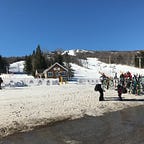Often times when I hear people talking about the largest ski areas in North America, I hear them ask what exactly qualifies as “one” ski area.
Case 1: Connected via trails and under one ticket
Example: Jay Peak, Vermont
With this example, you can ski from anywhere to anywhere else on one pass without taking a long connecting lift. Most ski areas are of this type. This is our baseline for “one” ski area.
Case 2: Long connector trails
Example: Smuggler’s Notch, Vermont
In this case, single trails provide crucial connections between mountains. Resorts with long connector trails are almost unanimously agreed to still be one mountain.
Case 3: Connector lift under one ticket
Example: Stowe, Vermont
In this case, terrain in one area is separated via another by terrain that cannot be skied through (in this case, Vermont route 108), and a lift has to be ridden to get from one side of the resort to the other.
Case 4: the connector lift under multiple tickets, but still marketed as one ski area
Example: Sugarbush, Vermont
In this case, two separate sets of lifts and trails are connected via a long lift. When this lift is not running, there is no connection between these sets of trails without leaving the resort boundary. A cheaper lift ticket is also sold that only accesses one side of the resort, rather than both.
Case 5: Shuttle bus
Example: Loveland, Colorado
In this case, you are required to take off your skis and leave the resort boundary on a resort-run shuttle to reach another area of the resort.
Case 6: Connected, but owned by separate parties and marketed as separate ski areas
Example: Alta/Snowbird, Utah
In this case, the two areas are officially connected, but are owned by separate parties and are advertised entirely as separate ski areas, despite functioning more similarly to one resort than two.
So what do you think? Do all of these qualify as one resort? Where do you draw the line?
